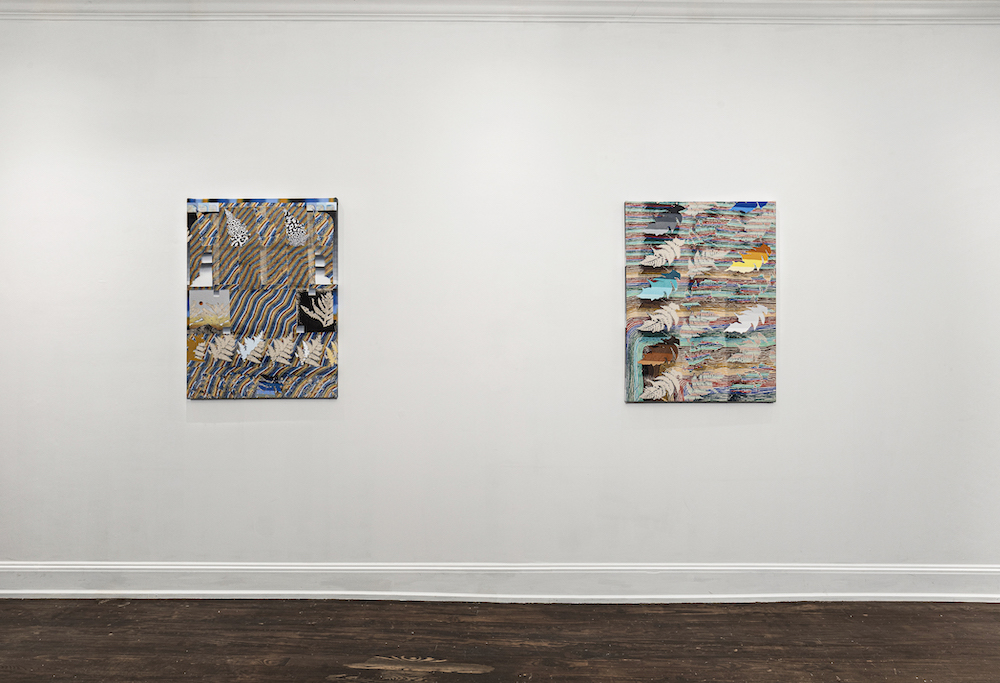Will Hutnick’s practice resists easy categorization. While largely using the language of abstraction, his mixed media paintings also borrow elements of glitch art with seemingly disjointed imagery that is somehow both static and in motion as patterns, shapes, and colors overlap. Hutnick incorporates elements grounded in reality, such as flowers and ferns (sometimes made from actual flora used as stencils). These sit atop layers of colorful patterns that recall stratigraphic lines and the wind’s waves that ripple across a stretch of sand. These components—created with a variety of materials, including acrylic, ink, marker, wax, spray paint, and colored pencil—form compositions that appear like patchwork or a palimpsest, as if the artist has excavated the layers to reveal imagery hidden underneath. Needless to say, Hutnick’s work is visually complex.
In his current solo show, “SATTELITE” at Geary in Millerton, New York, Hutnick’s latest body of work blends natural and otherworldly elements in paintings that seem to vibrate with subtle motion. As the exhibition title suggests, there is a cosmic element to the works on view. In several compositions, Hutnick uses a black-and-white pattern that resembles the surface of the moon. At times, the artist is more literal with the lunar inspiration with crescent shapes resting on a horizon line in Spooky Action #1 and #2 (both 2024). In other instances, the references are subtle, allowing the viewer to slowly digest each form, as seen best in Weather Patterns (2024). In this work, Hutnick includes two large rectangles of this extraterrestrial landscape. Paired with striations of earthly brown tones, it’s hard to tell what planet we’re on. Indeed, with these warmer hues, the moonscape begins to resemble black-and-white satellite imagery.
Other earthly references emerge throughout the show, notably the ferns and flowers that adorn several works. Hutnick also incorporates triangles reminiscent of tall mountain peaks, as seen in Loose Future #1, #2, and #3 (all 2024). In these, leafy plants resembling evergreen trees stand before black-and-white, cheetah-print mountains. Contained in a rectangular vignette on the bottom left of each composition, these mountain vistas sit in a background of horizontal gray-scale bands. Big patches of blurred white, gray, and black interrupt these horizontal lines like clouds in the gray sky. While sprinkled with recognizable imagery, the meanings of Hutnick’s works are ambiguous. For me, these three compositions instantly recalled the sublime beauty of Killington, Vermont seen from the mountain resort’s chairlift as you climb higher towards the peak, the gray sky an auspicious sign of impending fresh powder.
The word “satellite” also relates to the arrangement of shapes on the surface of some works. In Unknown Pleasures in a Blood Red Summer (2024), repeated fern motifs seem to hover above a rainbow field as if the viewer is looking down from outer space. The same perspective appears in Shake the Sheets (2023), in which rows of colorful leaves float above a striped pattern that resembles tree rings or the inside of a geode, additional nods to the natural world.
In other works, this sense of space is obscured as foreground and background constantly shift. In Photopsia (2024), shapes and patterns seem to vibrate next to one another. Small flowers hover similarly to the satellite-like forms, but Hutnick has replaced the more cohesive background with several patches of colors and patterns. A black-and-white design that resembles a cheetah print creates a ring around the entire composition as if the viewer is looking through a kaleidoscope. Each shape seems to have settled into its unique arrangement, yet it’s hard not to think that the whole piece could easily shift and fall into a new configuration with one turn of the lens.
Indeed, throughout “SATELLITE,” there is a sense of order and intentionality in the way each individual form is carefully arranged to interact with one another and with the composition as a whole. Yet, at times, this order shifts as the eye takes in additional information in the colors, shapes, and textures. Perhaps this is the best way to define Hutnick’s practice—like looking through a kaleidoscope. After all, the Greek roots for the word kaleidoscope translate to “the observation of beautiful forms.”



















0 Comments